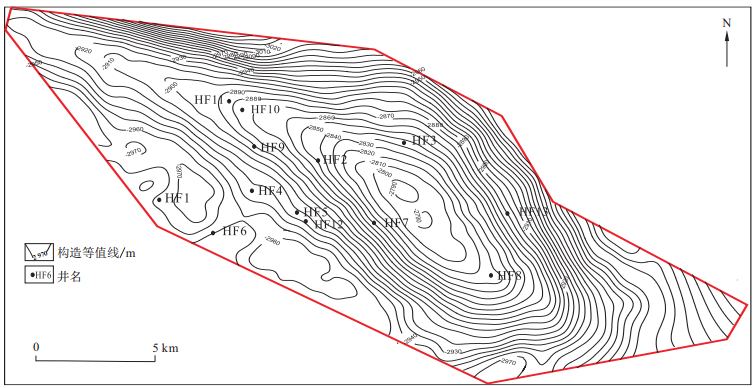Application of conventional logging and gas logging data to fluid identification of carbonate reservoirs in K reservoir of H Oilfield
-
摘要:
K油藏是中东伊拉克H油田重要的油气产层, 储层裂缝基本不发育, 储集空间主要为基质孔隙和溶孔, 渗透率极差范围大, 孔渗相关性较差。储层厚度大, 层间非均质性极强, 使得仅依靠常规测井资料和传统的测井评价方法来评价该区域碳酸盐岩储层流体性质识别效果差, 针对该问题, 进行H油田K油藏流体识别研究。通过分析常规测井资料发现, 深浅电阻率比值可以较好地划分水和烃类。在分析总结气测全烃曲线的形态特征及所对应的储层流体性质基础上, 发现气测曲线对于不同流体性质形态差异明显, 因此考虑利用气测曲线进行水和烃类进一步划分。统计发现重烃比值和烃气密度指数可以较好划分油水同层和水层, 为了定量表征识别过程建立水层-油水同层气测曲线识别法(ECR1), ECR1大于0为油水同层, 反之为水层。以烃气湿度指数、轻烃比值、挖掘效应可以较好划分气层和油层, 以此为基础建立气层-油层气测曲线识别法(ECR2), ECR2大于0为气层, 反之为油层。以该模型对H油田K油藏13口井38个小层的应用表明, 其识别符合率达到81.58%, 识别精确度高, 能满足研究区实际需要。通过建立的气测曲线识别法(ECR)模型, 在H油田K油藏取得较好应用效果, 可为本区块后续勘探开发具有一定借鉴意义, 同时也可以为国内外类似碳酸盐岩储层流体识别提供参考。
Abstract:K reservoir is an important oil and gas producing layer of H oilfield in the Middle East, Iraq. The reservoir space is mainly matrix pores and dissolved pores, with a wide range of permeability and poor correlation between porosity and permeability. The reservoir thickness is large, and the stratigraphic heterogeneity is very strong; therefore, it is poor quality to identify carbonate reservoir fluid properties only relying on conventional logging data and traditional logging evaluation methods. Aiming at this problem, the fluid identification work of K reservoirin H oilfield was carried out. By analyzing conventional logging data, it is found that the ratio of deep to shallow resistivity can better distinguish water from hydrocarbon. Based on analyzing morphological characteristics of the total hydrocarbon curve and corresponding reservoir fluid properties, it is found that the gas curve has obvious differences in the morphology of different fluid properties, so it is considered to further classify water and hydrocarbon by using gas curve. It is found that the ratio of heavy hydrocarbon tohydrocarbon gas density index can better classify oil-water layer and water layer. In order to quantitatively characterize the identification process, the identification method of water-oil-water layer gas measurement curve (ECR1) is established. ECR1 greater than 0 is oil-water layer, otherwise, it is water layer. Based on gas wet index, light hydrocarbon ratio and excavation effect, the identification method of gas-reservoir gas measurement curve (ECR2) is established. ECR2 higher than 0 isgas reservoir, and vice versa. The application of this model to 38 small layers in 13 wells of K reservoir in H oilfield shows that the recognition coincidence rate reaches 81.58%, and the recognition accuracy is high, meeting the actual needs of study area. The established ECR model has achieved good application effect in K reservoir of H oilfield, which can provide a certain reference for the subsequent exploration and development of this area, and also provide a reference for fluid identification of similar carbonate reservoirs worldwide.
-
Key words:
- K reservoir /
- carbonate reservoir /
- fluid identification /
- gas logging /
- excavation effect
-
表 1 K储层参数简表
Table 1. Summary of the parameters of K reservoir
地层 细分层 平均厚度/m 孔隙度/% 渗透率/10-3 μm2 K KA KA1-1 27 10.45 0.29 KA1-2 KA2 37 9.62 0.14 KB KB-1 19 11.69 1.2 KB-2 KB-3 表 2 K油藏流体响应特征
Table 2. Reservoir fluid response characteristics of K
流体类型 气测响应 电阻率 声波 密度 中子 挖掘效应 气层 明显,呈“箱状” RT/RXO>1, 电阻率中到高 明显增大 明显降低 明显降低 明显, 受物性影响 油层 较为明显,呈“单尖峰状” RT/RXO>1, 电阻率中等,少量较高 增大,不明显 降低 降低 挖掘效应不明显 油水同层 较为明显,呈“三角形状” RT/RXO < 1, 电阻率较低 相对于非储层段降低 相对于非储层段降低 相对于非储层段降低 无挖掘效应 水层 不明显 RT/RXO < 1, 电阻率低 相对于非储层段降低 相对于非储层段降低 相对于非储层段降低 无挖掘效应 注:RT/RXO为深浅电阻率比值 表 3 ECR方法计算结果验证
Table 3. Verification of ECR calculation results
井名 深度/m 解释结论 挖掘效应指数 重烃比值 烃气密度指数 烃气湿度指数 轻烃比值 ECR1 ECR2 符合情况 HF1 2 935.0~2 941.0 油层 -0.039 0.074 5.684 16.231 10.391 -0.923 符合 2 979.0~2 985.0 油水同层 -0.028 0.062 6.350 19.244 11.087 0.266 符合 2 989.0~2 991.0 水层 0.003 0.076 3.178 19.780 13.002 -0.602 符合 2 992.0~2 996.0 水层 -0.056 0.075 3.286 19.879 12.646 -0.566 符合 HF2 2 814.0~2 823.0 气层 0.020 0.056 5.713 27.858 13.745 -0.516 不符合 2 866.0~2 869.0 气层 0.113 0.056 5.392 36.060 15.200 0.844 符合 2 969.1~2 874.0 气层 0.153 0.048 5.235 42.557 16.988 0.896 符合 HF3 2 802.0~2 808.0 油层 -0.009 0.054 7.738 26.663 12.921 -0.879 符合 2 858.0~2 862.0 气层 0.012 0.029 10.069 55.489 18.745 -0.735 不符合 2 863.0~2 867.0 气层 0.157 0.031 9.252 57.131 19.335 0.935 符合 HF4 2 900.0~2 909.0 油层 -0.012 0.048 8.213 31.150 14.874 -0.879 符合 2 951.0~2 953.0 油层 0.017 0.051 7.524 31.479 14.477 -0.438 符合 2 954.0~2 957.0 油层 0.063 0.059 7.114 26.572 13.244 0.410 不符合 2 958.0~2 961.0 油层 0.022 0.055 7.242 28.999 13.900 -0.541 符合 HF5 3 012.0~3 015.0 油层 0.009 0.096 4.603 9.911 8.729 -0.713 符合 3 017.0~3 020.0 油层 0.010 0.078 4.732 18.725 10.335 -0.668 符合 3 021.0~3 025.0 油层 0.014 0.076 4.033 16.904 10.781 -0.745 符合 HF6 2 958.0~2 961.0 油水同层 -0.008 0.065 7.308 16.795 10.219 0.351 符合 HF7 2 800.0~2 810.0 气层 0.063 0.036 8.180 42.860 15.826 0.451 符合 2 856.0~2 862.0 气层 0.049 0.024 10.245 69.165 20.246 0.253 符合 HF8 2 836.0~2 839.0 气层 -0.009 0.071 3.773 35.969 15.604 -0.707 不符合 2 840.0~2 845.0 气层 0.038 0.022 83.186 16.698 7.531 0.159 符合 2 846.0~2 850.0 气层 0.030 0.041 19.181 23.803 10.389 0.110 符合 HF9 2 857.0~2 868.0 油层 0.003 0.066 6.503 18.070 11.066 -0.836 符合 2 907.0~2 911.0 油层 -0.010 0.049 7.051 30.401 13.742 -0.796 符合 2 912.0~2 916.0 油层 0.033 0.048 7.097 30.488 13.753 -0.395 符合 2 917.0~2 922.0 油层 0.049 0.046 7.468 29.590 13.764 0.109 不符合 HF10 3 063.0~3 067.0 油层 0.029 0.089 2.338 44.084 21.769 -0.277 符合 3 070.0~3 078.0 油层 0.027 0.062 3.472 43.984 20.004 -0.416 符合 3 080.0~3 088.0 油层 0.025 0.070 3.675 37.246 17.924 -0.541 符合 HF11 2 902.0~2 906.0 油层 0.024 0.093 6.552 10.078 8.477 -0.400 符合 2 907.0~2 910.0 油层 0.001 0.099 5.682 10.669 8.805 -0.838 符合 2 912.0~2 919.0 油层 0.033 0.193 3.456 7.546 7.486 -0.332 符合 HF12 3 104.0~3 109.0 油层 0.030 0.032 6.698 69.867 22.583 -0.298 符合 3 110.0~3 116.0 油层 0.080 0.035 7.296 53.573 19.326 0.590 不符合 HF13 2 863.0~2 864.9 油水同层 0.020 0.068 3.911 25.645 13.929 -0.390 不符合 2 865.0~2 869.0 水层 0.015 0.089 4.020 19.084 11.694 -0.665 符合 2 870.0~2 875.0 水层 0.021 0.102 3.311 14.690 10.609 -0.776 符合 -
[1] 韩国生, 李双龙, 张继德, 等. 气测录井在辽河坳陷非常规储集层解释评价中的应用[J]. 录井工程, 2010, 21(4): 24-29, 74. doi: 10.3969/j.issn.1672-9803.2010.04.007Han G S, Li S L, Zhang J D, et al. Application of gas logging in interpretation and evaluation of unconventional reservoirs in Liaohe Depression[J]. Logging Engineering, 2010, 21(4): 24-29, 74(in Chinese with English abstract). doi: 10.3969/j.issn.1672-9803.2010.04.007 [2] Haworth J H, Sellens M, Whittaker A. Interpretation of hydrocarbon shows using light(C1-C5) hydrocarbon gases from mud-log data[J]. AAPG Bulletin, 1985, 69(8): 1305-1310. [3] 何宏, 童锡骏, 安源. 对气测录井烃组分三角形图解法的研究[J]. 天津理工学院学报, 2004, 21(2): 30-33. doi: 10.3969/j.issn.1673-095X.2004.02.008He H, Tong X J, An Y. Research on triangle illustration to gas logging hydrocarbon component[J]. Journal of Tianjin University of Technology, 2004, 21(2): 30-33(in Chinese with English abstract). doi: 10.3969/j.issn.1673-095X.2004.02.008 [4] 丁次乾. 矿场地球物理[M]. 山东东营: 石油大学出版社, 1992.Ding C Q. Field geophysics[M]. Dongying Shandong: Petroleum University Press, 1992(in Chinese). [5] 汪瑞宏, 李兴丽, 崔云江, 等. 气测录井技术在渤海疑难层流体识别中的应用[J]. 石油地质与工程, 2013, 27(1): 72-75, 140. doi: 10.3969/j.issn.1673-8217.2013.01.020Wang R H, Li X L, Cui Y J, et al. Application of gas logging technology in fluid identification of difficult formation in Bohai Sea[J]. Petroleum Geology and Engineering, 2013, 27(1): 72-75, 140(in Chinese with English abstract). doi: 10.3969/j.issn.1673-8217.2013.01.020 [6] 胡延忠, 吴文明, 孟建华. 气测录井烃类比值和烃气指数图板的建立与应用[J]. 录井工程, 2009, 20(2): 11-13, 52, 82-83. doi: 10.3969/j.issn.1672-9803.2009.02.003Hu Y Z, Wu W M, Meng J H. Establishment and application of hydrocarbon ratio and hydrocarbon gas index chart board in gas logging[J]. Logging Engineering, 2009, 20(2): 11-13, 52, 82-83(in Chinese with English abstract). doi: 10.3969/j.issn.1672-9803.2009.02.003 [7] 魏峰, 李跃林. 基于测录井资料的复杂流体性质识别技术[J]. 断块油气田, 2020, 27(6): 760-765. https://www.cnki.com.cn/Article/CJFDTOTAL-DKYT202006018.htmWei F, Li Y L. Identification technology of complex fluidpropertiesbased on logging and mud logging data[J]. Fault-Block Oil & Gas Field, 2020, 27(6): 760-765(in Chinese with English abstract). https://www.cnki.com.cn/Article/CJFDTOTAL-DKYT202006018.htm [8] 祁新忠, 张承森, 高楚桥, 等. 塔中地区碳酸盐岩天然气藏流体识别方法研究[J]. 石油天然气学报, 2012, 34(9): 89-92, 7. doi: 10.3969/j.issn.1000-9752.2012.09.018Qi X Z, Zhang C S, Gao C Q, et al. Study on fluid identification method of carbonate gas reservoir in Tazhong area[J]. Journal of Oil and Gas Technology, 2012, 34(9): 89-92, 7(in Chinese with English abstract). doi: 10.3969/j.issn.1000-9752.2012.09.018 [9] 杨毅, 袁伟, 杨冬, 等. 综合测录井信息的砂砾岩储集层流体性质识别方法[J]. 录井工程, 2020, 31(4): 77-83. doi: 10.3969/j.issn.1672-9803.2020.04.012Yang Y, Yuan W, Yang D, et al. Identification method of fluid properties of glutenite reservoirs based on integrated information of well logging and mud logging[J]. Logging Engineering, 2020, 31(4): 77-83(in Chinese with English abstract). doi: 10.3969/j.issn.1672-9803.2020.04.012 [10] 武鑫, 王艺霖, 黄敬军, 等. 徐州地区碳酸盐岩溶蚀特征及影响因素分析[J]. 地质科技情报, 2019, 38(3): 120-126. https://www.cnki.com.cn/Article/CJFDTOTAL-DZKQ201903011.htmWu X, Wang Y L, Huang J J, et al. Dissolution characteristics of carbonate and analysis of the key influence factors in Xuzhou region[J]. Geological Science and Technology Information, 2019, 38(3): 120-126(in Chinese with English abstract). https://www.cnki.com.cn/Article/CJFDTOTAL-DZKQ201903011.htm [11] Volery C, Davaud E, Foubert A, et al. Lacustrine microporous micrites of the Madrid Basin(Late Miocene, Spain) as analogues for shallow-marine carbonates of the Mishrif reservoir Formation(Cenomanian to Early Turonian, Middle East)[J]. Facies, 2010, 56(3): 385-397. doi: 10.1007/s10347-009-0210-8 [12] 徐辉. 伊拉克AHDEB油田上白垩统Khasib组碳酸盐岩储层特征研究[D]. 成都: 西南石油大学, 2018.Xu H. Iraq AHDEB Oilfield carbonate reservoir characteristics of Khasib Formation in Upper Cretaceous[D]. Chengdu: Southwest Petroleum University, 2018(in Chinese with English abstract). [13] 柳万里, 晏鄂川, 戴航, 等. 南漳保康两县碳酸盐岩崩塌发育特征及影响程度分区[J]. 地质科技通报, 2020, 39(2): 104-112. doi: 10.19509/j.cnki.dzkq.2020.0211Liu W L, Yan E C, Dai H, et al. Development characteristics and influence degree zoning of carbonate rock collapse in Baokang and Nanzhang counties[J]. Bulletin of Geological Science and Technology, 2020, 39(2): 104-112(in Chinese with English abstract). doi: 10.19509/j.cnki.dzkq.2020.0211 [14] 李长海, 赵伦, 刘波, 等. 碳酸盐岩裂缝研究进展及发展趋势[J]. 地质科技通报, 2021, 40(4): 31-48. doi: 10.19509/j.cnki.dzkq.2021.0403Li C H, Zhao L, Liu B, et al. Research status and development trend of fractures in carbonate reservoir[J]. Bulletin of Geological Science and Technology, 2021, 40(4): 31-48(in Chinese with English abstract). doi: 10.19509/j.cnki.dzkq.2021.0403 [15] 韩金虎, 郭小文, 王学军, 等. 渤南洼陷不同来源原油分布规律及主要控制因素[J]. 地质科技通报, 2020, 39(6): 83-92. doi: 10.19509/j.cnki.dzkq.2020.0607Han J H, Guo X W, Wang X J, et al. Distribution rule andmain controlling factors of crude oil from different sources in BonanSag[J]. Bulletin of Geological Science and Technology, 2020, 39(6): 83-92(in Chinese with English abstract). doi: 10.19509/j.cnki.dzkq.2020.0607 [16] Liu H Y, Shi K B, Liu B, et al. Characterization and identification of bioturbation-associated high permeability zones in carbonate reservoirs of Upper Cretaceous Khasib Formation, AD Oilfield, central Mesopotamian Basin, Iraq[J]. Marine and Petroleum Geology, 2019, 110, 747-767. doi: 10.1016/j.marpetgeo.2019.07.049 [17] 徐星, 赵丽敏, 田中元, 等. 高气油比油层测井挖掘效应定量计算及应用[J]. 大庆石油地质与开发, 2015, 34(5): 151-155. https://www.cnki.com.cn/Article/CJFDTOTAL-DQSK201505029.htmXu X, Zhao L M, Tian Z Y, et al. Quantitative calculation and application of the logging excavation effect for high-gor oil reservoir[J]. Petroleum Geology and Oilfield Development in Daqing, 2015, 34(5): 151-155(in Chinese with English abstract). https://www.cnki.com.cn/Article/CJFDTOTAL-DQSK201505029.htm [18] 陈剑新. 钻井现场油气层快速评价方法及应用[J]. 海洋石油, 2001, 21(1): 26-30. https://www.cnki.com.cn/Article/CJFDTOTAL-HYSY200101005.htmCheng J X. Rapid evaluation method of oil and gas reservoir in drilling site and its application[J], Offshore Oil, 2001, 21(1): 26-30(in Chinese with English abstract). https://www.cnki.com.cn/Article/CJFDTOTAL-HYSY200101005.htm [19] 曾亚丽. 复杂储层流体识别方法研究[D]. 山东青岛: 中国石油大学(华东), 2014.Zeng Y L. Study on themethods of fluid identification of complex reservoir[D]. Qingdao Shandong: China University of Petroleum(Huadong), 2014(in Chinese with English abstract). [20] 毛志强, 谭廷栋. 密度测井和中子测井的相关性及其在识别天然气层中的应用[J]. 地球物理学报, 1996, 42(1): 125-133. https://www.cnki.com.cn/Article/CJFDTOTAL-DQWX601.013.htmMao Z Q, Tan T D. The correlativity of density log and neutron log and its application in identifying gas formations[J]. Acta Geophysica Sinina, 1996, 42(1): 125-133(in Chinese with English abstract). https://www.cnki.com.cn/Article/CJFDTOTAL-DQWX601.013.htm -





 下载:
下载:













